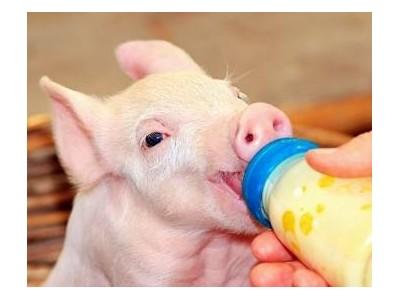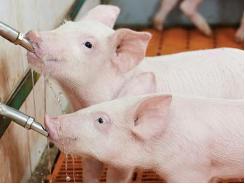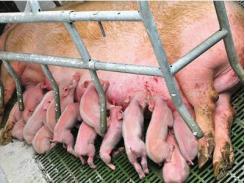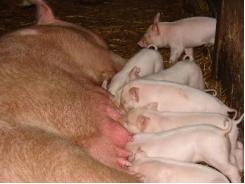Liquid milk replacers - which one is best?

Piglets have an enormous capacity for milk intake.
Offering a liquid milk replacer to piglets, either before or after weaning, is a difficult management decision as the cost is rather high. But, once the decision is made, how do we select the best milk replacer powder?
The natural milk produced by sows is very rich in fat; about 8 percent on a liquid basis and 40 percent on a dry matter basis. An ideal milk replacer powder, therefore, used at a mixing rate of 20 percent (to obtain a consistency equal to that of sow's milk) would be very difficult to manufacture and almost impossible to market, due to high fat content and prohibitive cost.
Commercial products
Most commercial milk replacer powders are mixed with water at a rate of 10-15 percent. This is a thinner solution, of course, but one that is both marketable and manageable as the dry powder contains no more than 10-15 percent fat and less than 20 percent protein. As such, one kilogram of a typical liquid milk replacer equals about half kilogram of sow's milk, giving a quick 2:1 rule of thumb. Although a commercial liquid milk replacer contains less energy than sow's milk, piglets have an enormous capacity for milk intake, and thus, this dilution does not constitute a setback in total nutrient intake, even when the milk replacer is used for orphan piglets as their sole source of nourishment.
Emphasis on ingredients
Although nutrient specifications are important when selecting among different products, even more important is the ingredient composition of a high quality commercial milk replacer powder. This is because in very young pigs, their digestive capacity is suited best to digesting milk components. Thus, suitable ingredients include skim milk, whey, lactose and buttermilk. Equally easily digested ingredients include coconut fat and most high quality vegetable oils, sucrose and dextrose. In addition, refined vegetable proteins, such as soy protein concentrate, potato protein, and wheat gluten are also considered desirable, but only in restricted amounts.
Additives
When it comes to additives, two products are the most important in deciding quality of the final product: lecithin and organic acids. Lecithin is an emulsifier that enhances the mixing characteristics of the liquid milk replacer. Organic acids are used to prolong the shelf-life of the prepared liquid milk replacer. Of course, in most commercial products a sweetener and (or) an aroma are also added, mostly for marketing and brand-identity purposes.
Immunoglobulins
Today, most products of the highest quality are fortified with a source of immunoglobulins because sow's milk is a rich source of these "functional nutrients." The three sources of immunoglobulins are dried bovine colostrum (used rarely because of excessive cost), dried animal plasma (relatively less expensive), and egg-derived immunoglobulins (least expensive). Milk replacers without immunoglobulin fortification can definitely nourish the pigs but they cannot protect gut health, offering thus only half of the features piglets enjoy through natural milk.
Physical characteristics
The most important physical characteristics of any high quality milk replacer include (1) stability in solution for up to two days, and (2) high solubility with minimal fat separation and protein flocculation. It is best to first follow the manufacturer's instructions before starting to experiment with water temperature, mixing time, and dilution rate to suit specific needs for each farm.
Ioannis Mavromichalis, Ph.D., is Nutrition Editor for WATTAgNet and Editor-in-Chief of Pig International.
Related news
Tools

Phối trộn thức ăn chăn nuôi

Pha dung dịch thủy canh

Định mức cho tôm ăn

Phối trộn phân bón NPK

Xác định tỷ lệ tôm sống

Chuyển đổi đơn vị phân bón

Xác định công suất sục khí

Chuyển đổi đơn vị tôm

Tính diện tích nhà kính

Tính thể tích ao




 Replacing expensive lactose in piglet feeds
Replacing expensive lactose in piglet feeds  12 tips for feeding hyperprolific lactating sows
12 tips for feeding hyperprolific lactating sows